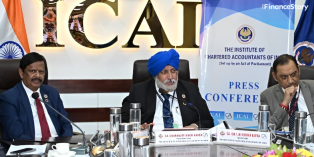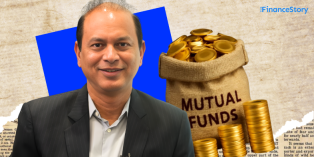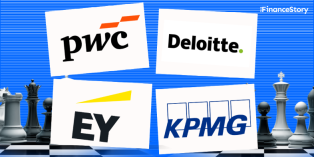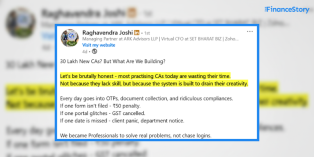- Meet Amitesh Kumar, an MBA with a keen interest in agribusiness and rural management.
- Currently, he is COO and CFO at Midland Microfin Limited (MML), the first microfinance institution based out of the Punjab Region.
- The company was conceptualized after realizing the great need for organized rural finance, especially for women. Technology helped them automate processes, store information on the cloud, and enhance effectiveness.
- As part of the Digital Transformation Series powered by DELL Technologies, we spoke to Amitesh to understand his journey as CFO in this technology-driven world.
Please tell us a little about yourself
I come from Bihar and grew up in a conservative middle-class humble family where my father worked with the State Government Department while my mother was a homemaker.
For those who don’t know about Bihar back then its economic and social rankings were quite low when compared to other states of India. So, growing up we faced hardship and obstacles due to limited financial resources. However, with a positive attitude towards those obstacles, I gradually become stronger and more successful.
After finishing my 12th Grade, I qualified for the national entrance in Agricultural Research, with a paid scholarship.
Although it was difficult, I graduated and decided to pursue an MBA because I had a keen interest in the field of agribusiness, and rural marketing & finance.
During my internship in extreme rural areas, I was inspired by Muhammad Yunus’ autobiography, Banker to the Poor.
After reading that book and realizing the great need for organized rural finance, I got passionate about microfinance and thought I should turn my passion into a career.
In 2008, I got campus recruited at Bharat Financial Inclusion Limited (BFIL), which was India’s largest microfinance company at the time.
At BFIL, I got an opportunity to work with grassroots professionals and expand microfinance operations in 5 states north of India.
This opportunity helped me develop expertise in sales and rural marketing, business development, accounting, and financial management, fundraising, management reporting, and compliance and risk management.
Additionally, the opportunity helped me develop skills in managing large teams with great execution capabilities.
After spending nearly 3 years in BFIL, I met Mr. Amardeep Singh Samra, who was passionate to start microfinance operations in the northern part of India.
In 2011, MML was launched and I was lucky that I got the opportunity to work with Amardeep from the conceptualization stage of the company.
I am privileged to have gotten the opportunity from my board and management to work in both positions as a CFO and COO.
What does MML do?
MML is a non-banking financial company (NBFC), the first microfinance institution based out of the Punjab Region.
Since its inception, the organization has always focused on encouraging and empowering women entrepreneurs from the bottom pyramid section of society.
We provide support to economically and socially underprivileged sections of the society in their entrepreneurship journeys.
Our financial product offering comprises loans for joint liability groups, individuals, dairy farmers, water purifiers, and solar light providers.
The company is spread across 12 Indian states, mostly in the east and north, with more than 248 branches and over 2000 employees.
What is the role of technology at MML and how has MML evolved on the technology front?
The vision of our company clearly states that we always want to position ourselves as a techno-savvy microfinance institution.
Since we started in 2011, from day one, we tried to integrate technology in our organization as the landscape of microfinance was undergoing rapid changes.
I think post demonetization (2014), the entire ecosystem and the banking, financial services, and insurance industry moved forward in such a way that companies who do not focus on technology would become obsolete over time.
After 2014, we then focused on improving 3 areas of our business: technology, innovation, and knowledge.
To name a few, some of our technological interventions include:
- Adoption of Customer-centric digital development backed by data. This helped us in improving the entire lending journey from acquisition to servicing by enabling customer profile-based offerings and a transition towards paperless lending procedures.
- Growth in cashless operations and digital payments. This curtails the risks of cash-based operations and improves operational efficiency and cost savings. Cashless models reported a reduction in turnaround time, reduction of risk of errors and fraud in disbursement and repayment
- Digital onboarding processes like digital signatures and E-KYC. This has brought huge gains in operating expenses but also changed the drivers of operating expense reduction.
- Capturing customer grievance through IVR & AI-based calling. This helps our company to improve client connect & improve customer satisfaction.
- Capturing & verifying the mobile number of members through an OTP-based process. This has helped us to increase customer connectivity.
- Introduction of Customer’s KYC and Bank accounts verification tools to reduce errors of fund transfers.
- CRM-based grievance redressal mechanism helped us to capture each & every grievance of the customer and help the closure of the same within TAT.
- Through Cloud-based mobile application enabled call centers not only promote work from home during pandemics but also improve customer connectivity & awareness on various points.
- Digital MIS & Dashboards improvises visibility of data to management which helps to make decisions.
- Geotagging our clients
How are you using artificial intelligence (IA), data analytics, and robotic process automation (RPA)?
We have partnered with a company to automate our entire back-end processes so that our turnaround time, credit processes, and client experience are improved.
In the company, we use AI in our contact centers to manage a large volume of calls with a human voice and completely remote analysis.
Customer grievances are also addressed within turnaround time with the help of technology. Furthermore, collections are also digitized to understand the behavior and sentiments of the borrowers predicting default rates.
In terms of collecting the money our people were not very disciplined and they were unable to follow up with the clients and for us, supervising them and monitoring them on a daily basis was quite challenging. So very recently we’ve partnered with the company called PayMee.
Based on their consumer behavior, their pattern, and their communication style they figure out the collection tendency of the clients and categorize the clients into different categories. Based on that we are creating strategies for our collections. So with the help of AI, we are actually monitoring consumer behavior based on their past repayment habits.
Over the last decade as a CFO, how has your role evolved? Did technology play a key role in the evolution of your role?
My role has definitely evolved because of technology. Now more than ever, it requires more than bookkeeping to enable management to make crucial business decisions.
Automation led to process error-free accounting and faster turnaround time. Also, we leveraged cloud accounting and mobility solutions to access data anywhere and anytime.
I have to mention that earlier the designation of the CTO was primarily to manage the IT infrastructure. The credit people, finance people, and official team brainstorm an idea and then they deliver the idea to the IT department. That’s how it was managed.
But nowadays the CTO has become the CTBO – Chief technical Business officer. They also understand both technology and business.
Being a techno-savvy resource person with relevant experience in business and finance, I interact with the team regularly.
My role is to understand what is happening in the industry and how we can integrate technology into our company. And then formally, I put forward the decision in front of the tech team and they execute our ideas in terms of designing the system as per our needs.
I have also led various technology transformation initiatives like the last mile, effective information exchange at the institutional level, various digital collection integration, integration of customer relationship management, and mobility solutions.
How did COVID-19 and the lockdown affect your business?
As technology is in the DNA of our company and we seek to stay prepared for anything, we were not badly affected.
Early adoption of technological tools enabled us to reach employees and clients remotely within the quickest possible time.
We also maintain constant touch and effective communication with our borrowers and employees.
What are your top priorities post-COVID-19?
Not only for us but also the entire microfinance sector, there are a few priorities:
- Automate manual tasks
- Move data to cloud servers
- More spending on the safety and wellbeing of employees
Lastly, do you think CFOs can play a key role in the digital transformation of an organization?
Globally you will see that if somebody holds a CFO position they have a better understanding of business and finance and are in a better position to contribute in terms of understanding customer expectations and fulfilling them.
Nowadays we all understand that the customer is the king and unless you don’t understand the consumer’s behavior and their needs and try to build products accordingly, you are not going to be able to manage a company properly. So, I think we have a better position in terms of understanding customer needs and their expectations and building products accordingly to please them.














